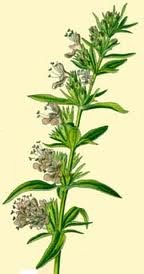|
|
 There are many plants called hyssop. After much discussion, it is now thought to
be origanum maru, which is also known as the Syrian or white marjoram, which
would have been indigenous to the Promised Land and its environs. They are
fragrant, wiry plants, up to three feet in height, but much less when growing,
as they often do, in rocky crevices or poor soil. Solomon bears this out when he
said of hyssop that springs out of walls (1 Kings 4.33). Their branches and
leaves are hairy and the flowers are white. As they are hairy they hold water
well. This is why they were used as sprinklers in religious ceremonies. Moses
directed that the 'hyssop' be used to sprinkle the blood of the Passover lamb on
the doorposts of the Hebrew homes in Egypt. (Exo.12.22).
There are many plants called hyssop. After much discussion, it is now thought to
be origanum maru, which is also known as the Syrian or white marjoram, which
would have been indigenous to the Promised Land and its environs. They are
fragrant, wiry plants, up to three feet in height, but much less when growing,
as they often do, in rocky crevices or poor soil. Solomon bears this out when he
said of hyssop that springs out of walls (1 Kings 4.33). Their branches and
leaves are hairy and the flowers are white. As they are hairy they hold water
well. This is why they were used as sprinklers in religious ceremonies. Moses
directed that the 'hyssop' be used to sprinkle the blood of the Passover lamb on
the doorposts of the Hebrew homes in Egypt. (Exo.12.22).
Also it was used to cleanse the lepers as in Leviticus 14.
"Purge me with hyssop, and I shall be clean: wash me, and I shall be whiter than
snow". Psalm 51.7.
Hyssop also appears in John 19.29 "a jar full of sour wine
stood there, so they put a sponge full of the sour wine on a hyssop branch and
held it to his mouth" (ESV). According to botanists and John Chancellor, this
would have been a reed as origanum maru would have been too small.
|